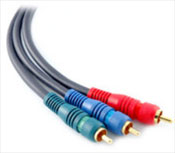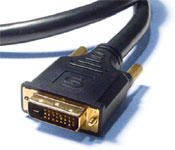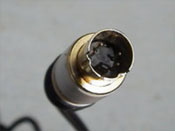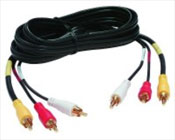Resource Guide Homepage
Resource Guide Homepage
Video Cables
When choosing cable to connect playback decks to display devices, be aware of the substantial spectrum of quality in the cable manufactured today. Cables should come from a reputable manufacturer and be composed of professional-grade parts. Video cable choices include digital (HDMI, etc.), component, S-Video, and composite. Both digital coaxial and fiber optic cables can carry multi-channel surround sound audio on a single cable.
HDMI (High-Definition Multi-media Interface) is an industry-supported, uncompressed, all-digital audio/video interface. HDMI is a descendant of DVI (Digital Visual Interface).
Component cables transmit analog video information as two or more separate signals. In the adjacent illustration three RCA com cables form the component video with combinations of the red, green, and blue signals that make up a television image.
DVI (Digital Visual Interface) is a video connector designed to maximize the visual quality of digital display devices such as flat panel LCD computer displays and digital projectors.
S-Video is also considered a component signal because the luminance (black and white) and chrominance (color) signals are transmitted on separate wires. S-Video is a single cable that does not include audio.
Composite, the oldest of video signals and still prevalent, combines both color (chrominance) and black and white (luminance) in one signal. This feature originally allowed for backwards compatibility with black-and-white televisions receiving off-air broadcasts, but created image problems not found in later S-Video or component signals. Today, a typical composite video signal uses a single coaxial wire, a yellow RCA connector for video, and a white and red RCA connector for stereo audio. A BNC connector is frequently found in professional applications.




